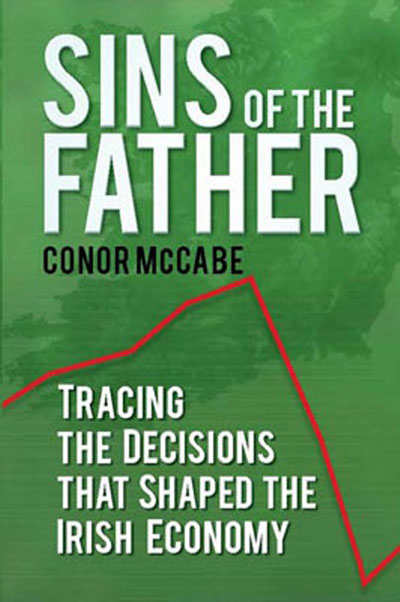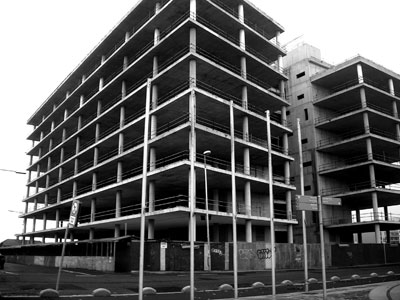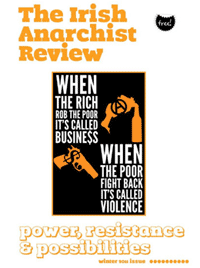Over 30 years of anarchist writing from Ireland listed under hundreds of topics
Interview: Conor McCabe on Sins of the Father
Date: Mon, 2011-10-17 15:10
 Journalist and writer Conor McCabe’s book ‘Sins Of The Father’ attempts, in the author’s own words, “…to shine a light on the reasons why Ireland has the businesses it has, and why banks and speculators yield so much power and influence.” The book has been acknowledged as a significant contribution to the analysis of the political and economic decisions that have brought the Irish economy to ruin. James McBarron interviewed McCabe for Irish Anarchist Review
Journalist and writer Conor McCabe’s book ‘Sins Of The Father’ attempts, in the author’s own words, “…to shine a light on the reasons why Ireland has the businesses it has, and why banks and speculators yield so much power and influence.” The book has been acknowledged as a significant contribution to the analysis of the political and economic decisions that have brought the Irish economy to ruin. James McBarron interviewed McCabe for Irish Anarchist Review
The chapter dealing with government policy on housing makes fascinating reading. To what extent do you think that the various housing action and squatter campaigns of the 70s effected any change - if only temporarily? Did the Trade Union movement at any point challenge the dominant direction of government policy?
Oh they had quite a positive result. The various housing action committees of the 1960s in Derry, Dublin, Cork and Galway, the Mountjoy Square occupations - they all immediately spring to mind. Their effectiveness I would say is gauged by the degree to which they’ve been left out of the mainstream historical narrative. Have a look at Reeling in the Years and it’s all Neil Blaney and Ballymun and the protests to save Georgian Dublin, and virtually nothing on activists such as Dennis Dennehey, Patrick Stanley, Seamus Rattigan, Mairin De Burca or Sean Dunne.
The same goes for the successful rent strikes of the early 1970s which were organised by the National Association of Tenants’ Organisations. There are lessons to be learned there, in terms of protest and organisation, which of course is why they’ve been left out of the mainstream historical narrative. I mean, the rent strikes alone provide a working template for any future mortgage strike – people paid their rent into a collective fund which was then used as a bargining chip once it came to settle arrears, legal assistance was provided, and test cases were put forward with the full backing of the collective resources of the protest movement.
In terms of their effect on government policy, there is little doubt that the last great wave of public housing construction in Ireland, which took place in the mid-1970s under a Labour party ministry, was influenced by the various protests and grassroots organisations. However, although the government was building public housing, it was selling off more by way of the tenant purchase scheme which had been brought in by Fianna Fáil in 1966.
In 1971 there were 112,320 local authority rental housing units in the State, which amounted to 15.9 per cent of the total households. By 1981 this figure dropped to 111,739 and now constituted 12.4 per cent of total households. Yet, there were 64,170 new local authority units completed between 1971 and 1980. The State was selling its public housing stock to its tenants quicker than it could replace it. The amount of households in urban areas in 1981 that either owned their property or were buying their house from a local authority was 65.5 per cent. In 1961 that figure was 37.9 per cent. The tenant-purchase scheme had been heavily utilised, and resulted in dramatic heavy selling of local authority housing. This practice, of course, was later copied by the Conservatives in Britain in the 1980s.
I think the trade union movement did influence government policy in terms of new public housing, especially during the 1970s Fine Gael/Labour coalition, but the game was already rigged by that stage, if you know what I mean. The move to create a debtor class by way of the mortgage market was already well under way. The scrapping of local authority rates in the late 1970s pretty much ended the presence of city and county councils in the mortgage market – up to then local authorities provided ‘affordable’ mortgages to those who wished to buy but did not have the wage levels or job security demanded by private mortgage lenders – but once that income stream was cut off, along with the privatisation of public housing, the only realistic option open to a young couple starting out was the purchase of a private mortgage at commercial rates. The amount of taxpayers’ money that successive Irish governments have spent in order to keep wages low in Ireland is quite staggering when you think about it. Partnership, of course, actively embraced that process.
Given the current glut of housing available in Ireland, how is that the rental sector has seen only minor falls in rent? Is this market being manipulated to suit the interests of private landlords and investors?
Yes, it is. The Irish government spends hundreds of million in taxpayers’ money every year in subsidising private landlords. The effect of privatising local authority housing has been that those who can not afford to buy a mortgage are pushed deeper into the unregulated, but deeply subsidised, private rental market. I’m afraid I don’t have more up-to-date figures but in 1999 almost 40 per cent of all tenants in private rented dwellings were in receipt of rent allowance. It cost the government £115 million, or €146 milion, that year in payments.
In 1981 that figure was £6.1 million (around €7.7 million). By 2005 it had risen to an estimated €380 million. The Irish State had gone from a policy of eradicating slum dwellings in the 1930s to actively subsidising private landlords and sub-standard dwellings. The expansion of the private rental market is official government policy. It is, after all, one of the criteria for Section 23 Tax Relief – that is, the construction of apartments for rent. The State has encouraged the expansion of landlordism, again with taxpayers’ money. The effect of privatising public housing is that the funding which would have gone to local authorities now went to private individuals and businesses – and all the time using public funds to force the closure of public housing, and all the time calling it ‘investment’.
But again, this is the grand theme of the Irish capitalist class. It is a comprador class. And rent, in all its forms and guises, is its business.
How do you see the current picture in agriculture; is the big farmer lobby still a major force or has its influence declined with the expansion of the economy into other areas; or is the recent rise in agricultural prices increasing the influence of this lobby?
There is still a huge class dynamic to Irish agriculture – Larry Goodman, for example, is still one of the biggest recipients of EU subsidy funds – so that the lobby that is there lobbies mainly in the interests of the ranchers and big farmers, rather than in the interests of the small and medium farmer. The various EEC and EU deals over the past forty years simply bear that out. However, there is a perception, particularly among the urban working population, that farmers are just that: ‘farmers’. No distinction is made between the size and income of the farms – or even that farming is a part-time occupation for many small and medium farmers, not because of any ‘lifestyle choice’ but because they have to work at another job in order to pay the bills.
The lack of awareness of the realities of the rural working class in Ireland - that there even is a rural working class in Ireland – has allowed the ranchers and big farmers to pretty much hold sway. The agriculture lobby is making minor gains, but its influence is dwarfed by that of the retail sector which pretty much bleeds farmers dry. Irish retail profits are simply off the map.
 Irish Industrial policy is hindered by the demands of vested interests right throughout the period you write about. The advent of the foreign direct investment policy does, in one sense, bring about a sea change with a noticeable rise in living standards and an expansion in employment. Did this create a tension with workers in the multi nationals enjoying higher wages and depending on those industries for their living, while others saw their traditional industries slowly decline?
Irish Industrial policy is hindered by the demands of vested interests right throughout the period you write about. The advent of the foreign direct investment policy does, in one sense, bring about a sea change with a noticeable rise in living standards and an expansion in employment. Did this create a tension with workers in the multi nationals enjoying higher wages and depending on those industries for their living, while others saw their traditional industries slowly decline?
It’s a really good question and one I’m afraid I’m not quite sure I can answer and still do it justice. That tension, between those employed in multinationals and those employed in the rest of the manufacturing and services sectors, is definitely there, and can be seen in the rugged defence of Ireland’s corporation tax rate not only by trade unions but by ordinary workers. Yet, Ireland’s corporation tax rate acts as a drain on the rest of the economy, as those sectors not covered by it have to cover the shortfall in income in order to pay for the maintenence and development of the State’s infastructure. But, it’s not seen that way, and certainly the Irish Financial Services Centre is seen as a talisman instead of the albatross that it is. But, a great question. I just wish I could answer it with more depth.
Do you think the overall direction of government policy was thought out on a fairly planned basis, or was it simply a case of vested interests fighting their corner and the consequences flowing naturally from that?
The Irish economy is a planned economy, no doubt about it. It has been since the foundation of the Free State in 1922. The plan has been to serve the interests of the particular type of capitalism which took root in Ireland – that is, a certain kind of comprador capitalism. I’m in danger of oversimpifying here but the type of business activities which dominated the Irish economy in the twentieth century – cattle exports to Britain and financial investment in London; the development of green-field sites and the construction of factories and office buildings to facilitate foreign industrial and commercial investment; the birth of the suburbs and subsequent housing booms predicated on expanding urban workforce – saw the development of an indigenous moneyed class based around cattle, construction and banking.
These sectional interests were able to control successive government policy, much to the detriment of the rest of the economy, which had to rely on whatever scraps it could pick up from quasi-committed multinationals and government-funded grants and tax breaks. In 2008 the construction and banking sectors of that class closed ranks in order to protect themselves from oblivion, resulting in the bank guarantee and the creation of the National Assets Management Agency.
There has been a logic to everything they have done, and once we see that Irish capitalism is a ‘meet-and-greet’ capitalism, then the decisions begin to make sense. Of course, that is not how the history of Ireland in the 20th century is portrayed. Take, for example, Fianna Fáil.
The image of Fianna Fáil as ruthless and politically brilliant has a long tradition within Irish journalism. The rise of the ‘mohair suits’ in the 1960s – the party’s post-revolution generation - and the apparent sophistication of its most controversial leader, Charles Haughey, brought a new lexicon into play which helped define the organisation in the public eye. Haughey was a republican who lived an aristocratic life. He had silk shirts flown in from Paris and made speeches of stoic patriotism. His party knew him as The Boss; his media advisor, P.J. Mara, referred to him as Il Duce. His protégé, Bertie Ahern, was described by the master as ‘the most skilful, the most devious, and the most cunning of them all’. The head of Fianna Fáil was often seen as like a Godfather who ruled through a mixture of patronage and (political) assassination. He was Marlon Brando, slowly rubbing his cheek while plotting a murder, immaculately dressed with manicured nails.
However, the proper analogy is not with Vito Corelone or his cold, calculating son, Michael; it is with Fredo, the middle son who is sent to Vegas to make sure all the high rollers are kept happy. It is Fredo, sweaty and unsure, desperately trying to please the powerful, who best fits the role of Fianna Fáil in Ireland. The party spent decades in service to particular business interests in this country, while doing just enough to convince the electorate to return it to office. That was its role because that was (and still is) the type of busineess that the Irish capitalist class engage in.
Conor, your book has been very well received on the left, provoking a lot of positive reviews and favourable comment. Has it got any comparable feedback in the mainstream media?
Not really, but I don’t see any great conspiracy there. The Irish Independent picked up on the book, particularly the chapter on housing, calling it myth-busting, and I’ve been asked onto a couple of radio shows, but really I have a very low profile anyway - I’m sure the first that people would have heard of me is through the book - so how would they pick up on me in the first place, you know?
As you said, the book is slowly making its way through the Irish Left, and really I’m so happy with that. Sins of the Father contains such a lot of previous research by other Left writers and activists - I’m thinking of people like Ray Crotty, Kieran Allen, Tara Jones, Chris Eipper and Robert Allen, as well as those associated with Left publications and organisations such as Ripening of Time, Resources Study Group, The Workers’ Party, The Communist Party of Ireland, Workers Solidarity Movement, Militant and Socialist Workers Movement, even the Communist Party of Ireland (Marxist-Leninist) – that hopefully it will lead to a re-discovery of the works I’ve drawn upon, that the Irish Left can actually look to its own history and its own body of work in order to make sense of this island we live upon. I look at the Irish Left and I see over 100 years of research and analysis. It’s an impressive body of work and I was so lucky to be able to use it. My ‘day job’ is that of a labour historian, so I not only knew the work was there, I had already engaged with a sizeable part of it. Hopefully the book will raise the profile of that body of work that is already there.
This article is from Irish Anarchist Review, Issue 4, October 2011



Comments
Tennant Purchase
"The effect of privatising local authority housing has been that those who can not afford to buy a mortgage are pushed deeper into the unregulated, but deeply subsidised, private rental market" My parents were one of those who were offered a tenant purchase agreement. We bought the house over a number of years. That house remains lived in by one of my family members and is unavailable to be occupied by those seeking to rent a place from the council. Later, (hopefully) it will be passed on to a member of our family and used as a starter home from which they can plan a life for themselves. BTW my father worked as a bus conductor and then bus driver with CIE for 35 years beginning in 1949 and ending in 1984 when he left CIE on the princely sum of £17 that right seventeen pounds a week. So his little reward of being offered a place of his own in a Limerick Housing estate was hardly extravagant? But maybe you think it was? Of course, the rent book my mother used to bring out to the door every week is now being re-instated in the form of a property tax. People are no longer going to be allowed to "own" their property in this state the state owns them and has put them in debt harness to service the "no bondholder will be left behind strategy of FF, FG, Labour and Greens Let's not forget Greens. . I see many contradictory allusions in your article above.